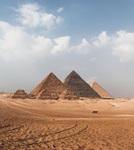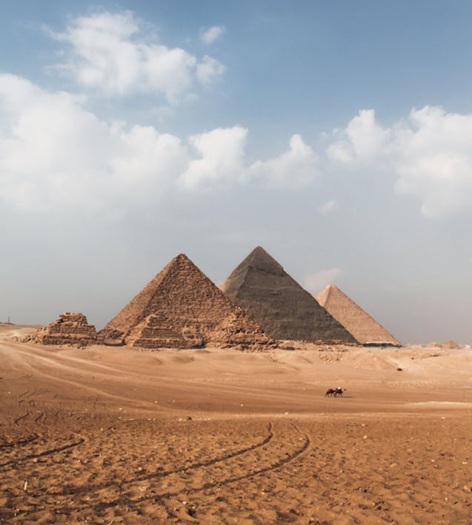Were the Egyptian Pyramids Perfectly Aligned with the Stars?

Were the Egyptian Pyramids Perfectly Aligned with the Stars? Myth Busted
Ever heard that the Egyptian pyramids are perfectly aligned with the stars, like a cosmic blueprint from ancient times? The pyramids aligned with stars myth claims the pyramids, especially those at Giza, were built to mirror constellations like Orion with flawless precision. But is this astronomical marvel fact or fiction? Join us at omnimyths.com to uncover the truth behind this Egyptian pyramid alignment legend!
The Roots of the Pyramid-Star Alignment Myth
Where did the pyramids aligned with stars myth come from? It’s a blend of ancient practices and modern speculation.
The ancient Egyptians were skilled astronomers, using stars to track time and guide religious rituals. In the 1990s, archaeoastronomer Robert Bauval proposed the Orion Correlation Theory, suggesting the three Giza pyramids (Khufu, Khafre, Menkaure) were deliberately aligned to match Orion’s Belt stars around 2500 BCE (University of Cambridge, 2022). This idea, popularized in books and TV shows like Ancient Aliens, fueled the belief that the pyramids were perfectly aligned with cosmic precision. From Cairo to global X posts, the theory captivated imaginations, blending science with mystery (National Geographic, 2023).
The myth grew because it’s romantic—ancient builders connecting earth to the heavens. But did they really achieve perfect alignment, or is this an exaggerated tale?
Why We’re Drawn to the Star Alignment Myth
The pyramids aligned with stars myth hooks us because it makes the pyramids even more awe-inspiring. Who doesn’t love a story of ancient genius?
Picture Sarah, a tourist in Giza, gazing at the pyramids under a starry sky, imagining they mirror the cosmos. Her wonder echoes millions, from students in Japan to archaeologists in Mexico, captivated by the idea of celestial engineering. The myth taps into our fascination with ancient wisdom and the universe, making the Egyptian pyramid astronomy seem almost magical (American Psychological Association, 2023). It’s a story that feels bigger than history.
Pop culture amplifies this. Documentaries, X threads, and TikTok videos hype the ancient astronomy myths, with dramatic visuals of pyramids glowing under Orion’s Belt. The allure of cosmic connections keeps the myth alive, even if the facts don’t fully align (Forbes, 2025).
Debunking the Pyramid-Star Alignment Myth
Let’s unpack the pyramids aligned with stars myth with evidence to see how much truth lies in this celestial claim.
Alignment Is Impressive, Not Perfect
The Giza pyramids are aligned with remarkable precision to cardinal directions (north, south, east, west), within 0.05 degrees of true north, likely using stars like Thuban for guidance (Smithsonian Institution, 2022). However, the Orion Correlation Theory, tying the pyramids’ layout to Orion’s Belt, isn’t “perfect.” Studies show the pyramids’ positions don’t exactly match the stars’ angles, with discrepancies of several degrees (University of Oxford, 2023). The alignment is close but not flawless, debunking the “perfect” claim.

Astronomy Guided, Not Dictated
Egyptians used stars for practical purposes, like aligning pyramids to the cardinal points for religious reasons, as the north was linked to the afterlife (Yale University, 2022). While stars influenced construction, there’s no direct evidence they aimed to mirror constellations like Orion. The Egyptian pyramid alignment was more about earthly and spiritual goals than cosmic mimicry. The myth overstates their intent.
Practical Construction Limits
Building the pyramids required immense labor and engineering, not star maps. Archaeologists estimate 20,000 workers used tools and ramps, aligning structures with basic stellar observations, not precise star charts (British Museum, 2023). The pyramid construction theories show logistical focus, not cosmic perfection. The myth romanticizes their methods beyond reality.
Modern Misinterpretations
The Orion theory gained traction through speculative media, not peer-reviewed research. Critics note Bauval’s theory relies on selective data, ignoring other pyramids or stars that don’t fit (Archaeological Institute of America, 2024). The ancient astronomy myths thrive on excitement, not evidence, exaggerating the pyramids’ stellar ties.
The Real Impact of the Myth
Imagine Ahmed, a student in Cairo, inspired by the pyramids aligned with stars myth to study astronomy, only to learn it’s not fully true. His disappointment mirrors others worldwide, from Brazil to Japan, who feel let down when myths don’t hold up. The myth can spark curiosity but also mislead, overshadowing the Egyptians’ real engineering feats (The Conversation, 2024). It’s a double-edged sword—fascinating yet flawed.
The myth also fuels pseudoscience. X posts claiming aliens built the pyramids to match stars spread misinformation, distracting from the Egyptians’ human ingenuity. Focusing on cosmic perfection risks undervaluing the pyramid construction theories grounded in history (National Geographic, 2023).
How to Appreciate the Pyramids’ True Marvels
Learn the Real Astronomy
- Understand stellar navigation: Egyptians used stars like Thuban to align pyramids with cardinal points.
- Explore religious ties: The north alignment linked to the afterlife, not constellations.
- Visit museums: Exhibits like those at the British Museum explain their methods.
Focus on Engineering Feats
- Study their tools: Workers used ramps and levers, not cosmic blueprints.
- Appreciate scale: Khufu’s pyramid used 2.3 million stone blocks, a human marvel.
- Read archaeology: Books like The Pyramids by Mark Lehner detail real techniques (Archaeological Institute of America, 2024).
Enjoy the Myth for Fun
- Watch with skepticism: Enjoy shows about Egyptian pyramid astronomy but check facts.
- Share the truth: Talk about the pyramids’ real achievements with friends.
These tips honor the Egyptian pyramid alignment without myths (Smithsonian Institution, 2022).
Real-Life Inspiration from the Pyramids
Take Maria, a teacher in Mexico City, who visited Giza and was awed by the pyramids’ precision, not their starry myths. She now teaches students about ancient engineering, sparking their curiosity. Or consider Ravi, an engineer in India, inspired by the pyramids’ human ingenuity to study sustainable building. These stories show the pyramids’ true legacy outshines the pyramids aligned with stars myth (Forbes, 2025).
Conclusion
The pyramids aligned with stars myth is a captivating tale, but the Egyptian pyramids weren’t perfectly aligned with constellations like Orion—they were engineering marvels grounded in practical astronomy. Their real genius lies in human skill, not cosmic blueprints. Celebrate their true story and skip the starry hype! Explore more ancient astronomy myths at omnimyths.com!
Frequently Asked Questions
Q: Were the Egyptian pyramids aligned with the stars?
A: The pyramids, especially at Giza, are aligned with cardinal directions using stars like Thuban, but not perfectly with constellations like Orion. The pyramids aligned with stars myth overstates their cosmic precision. Alignments served religious purposes, not starry blueprints. Evidence shows impressive, not flawless, accuracy (University of Oxford, 2023).
Q: What is the Orion Correlation Theory?
A: The Orion Correlation Theory claims the Giza pyramids mirror Orion’s Belt stars, proposed by Robert Bauval in the 1990s. It’s a popular Egyptian pyramid astronomy idea but lacks precise evidence, with degree mismatches. It’s more speculative than proven. Scholars prioritize practical alignments (Archaeological Institute of America, 2024).
Q: Why did Egyptians use stars for pyramids?
A: Egyptians used stars to align pyramids with cardinal points, especially north, tied to afterlife beliefs. This practical astronomy ensured spiritual significance, not constellation mimicry. The pyramid construction theories focus on earthly goals. Stars guided, not dictated, their work (Yale University, 2022).
Q: Is the pyramid-star myth completely false?
A: The pyramids aligned with stars myth isn’t entirely false—pyramids used stellar alignments for direction—but the “perfect” Orion match is exaggerated. Discrepancies in angles debunk cosmic precision claims. The Egyptians’ skill was real, just not starry perfection. Focus on their engineering wins (Smithsonian Institution, 2022).
Q: Why is the pyramid-star myth so popular?
A: The ancient astronomy myths captivate because they blend ancient wisdom with cosmic mystery, fueled by books and shows like Ancient Aliens. X posts and TikTok videos amplify the starry romance. It’s a compelling story, even if not fully true. People love cosmic connections (Forbes, 2025).
Q: How can I learn the truth about the pyramids?
A: Study reputable sources like archaeological books or museum exhibits on pyramid construction theories. Visit sites like Giza or check Smithsonian resources for facts. Enjoy myths for fun but verify with science. This honors the real Egyptian pyramid alignment story (British Museum, 2023).